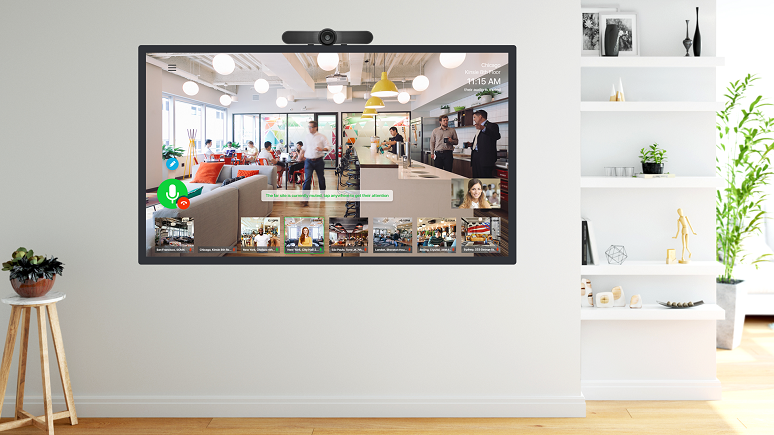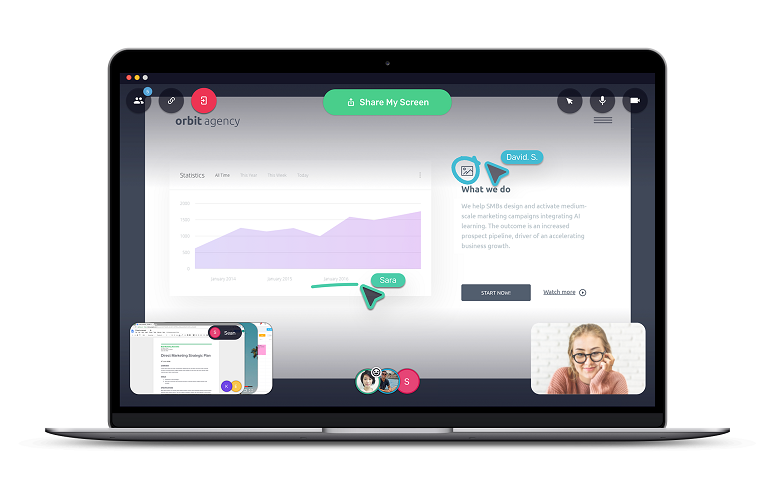In developing the conference program for the new
WorkSpace Connect event we’re hosting in September, I’ve been hearing the phrase “employee experience” quite a bit. Thought leaders from across the facilities/real estate, human resources, and technology domains emphasize the correlation between delivering a great employee experience and the all-important ability to attract and retain people.
Granted, the idea of what constitutes a great employee experience is subjective. But it’s a given that employees must feel connected, even if they never step foot in a corporate office. This isn’t a new theme. Remote workers haven’t suffered quietly when faced with, say, the inability to particulate fully in meetings with their in-office colleagues. In response to these demands, much meeting room technology aims to adapt to the audio, video, and content sharing needs of distributed teams… no more confusing dongles, single camera views, or hard-to-follow voices.
Now we’re seeing a next wave of innovation aimed at improving the meeting experience for employees outside the office.
Background Noise Be Gone
On the audio side, for example, I recently
wrote about the speakerphone Yamaha Unified Communications is developing for masking background noise in open workspaces. Among other capabilities, this phone will feature far field noise reduction technology for zeroing in on and capturing only the voices of people sitting around a meeting table, even it that table is situated in a chatty open office or noisy company café.
The device is meant to be portable, which means office-bound teammates can gather wherever they choose for an impromptu meeting, without worrying that remote participants won’t be able to hear the conversation due to background noise.
In the same vein, UC provider Deltapath early this year
announced that it has teamed with Dolby Voice to deliver the silent treatment during business calls burdened by productivity-blocking background noise. In a recent briefing, the company demonstrated how the technology, deployed on its mobile client, can mute sounds of a bustling airport terminal or busy downtown street so that on-the-go employees can participate in meetings without having the noises emanating from their surroundings kill the conversation.
The beauty of this technology is in the intelligence it has for identifying and blocking non-human noise, even if it’s at extremely high volume, said David Liu, founder and CEO of Deltapath, in a recent No Jitter briefing. By embedding Dolby Voice into its mobile app, Deltapath is able to turn an ordinary smartphone into a high-quality conference phone that also provides noise cancellation. “So when your customer calls, regardless of where you are and whether scheduled or not, you can still have a really good quality telephone call without worrying about finding a quiet place,” he said.
Note that the Dolby Voice technology has found its way into other meeting environments, too, through partnerships with other communications and collaboration vendors, including Blue Jeans Networks and Highfive.
Open the Window Into Your World
Collaboration Squared, participant in our
Innovation Showcase at Enterprise Connect back in 2015 for its cloud-based interoperability of video conferencing, Web collaboration, and phone conferencing, is approaching the challenge of enhancing the distributed employee experience from an entirely different angle. In May, the company launched an always-on immersive video conferencing portal called
Video Window.
The intent of Video Window isn’t to compete with in-room or desktop video meeting solutions but rather “to work alongside those for our specific use case,” said Daryl Hutchings, CEO of Collaboration Squared, in an email interview. That use case is the distributed team; the targeted location is the common gathering area; and the goals are enhanced human connection and improved team performance.
As the product name suggests, the idea is to provide distributed employees a window into the workplace throughout the workday; each Video Window can be assigned to a particular group, with times specified by administrators. Initiating the audio is a simple button-click, and a “knock, knock” feature allows a team member to tap on the screen to provide an audio attention-getter to a connected Video Window that’s been muted. The Video Window also supports whiteboarding, semi-transparently on top of the video.
In addition, an employee could use the screen to participate in a traditional video meeting, should that need arise. In such instances, which Collaboration Squared said should be infrequent, the company has included a SIP dialer. The user would simply exit Window mode and call into a one-to-one or multiparty video meeting just as if doing so from a conference room or desktop.
“Video Window offers the natural workflow that we have been looking for in business video for decades,” said David Maldow, collaboration industry analyst with Let’s Do Video, in a prepared statement.
Video Window, in beta now, comes bundled with necessary hardware or is available for purchase for use with a customer’s hardware (touchscreen, webcam, speaker, compute system) of choice. The Collaboration Squared hardware bundles will range in price from $3,000 to $8,000; the company will determine the annual SaaS licensing fee for Video Window when the product becomes generally available, Hutchings said.
Next-Gen Virtual Collaboration
One last example comes from Oblong Industries, known for its Mezzanine line of interactive, collaborative in-room, room-to-room, and room-to-remote meeting solutions. This time around, Oblong is taking aim at the collaboration experience of all-virtual teams via a product it calls
Rumpus. As I learned in a briefing this spring, Rumpus allows virtual team members to simultaneously share screens, point to and annotate on shared content, and react to content via the familiar social construct of emoji -- all without disrupting meeting flow.
“Rumpus isn’t just about sharing, but providing concurrent contribution and control … through the power of gesture and non-verbal communications,” said Dave Kung, vice president of product strategy at Oblong. “It’s about helping virtual teams feel more connected.”
Users can launch Rumpus to run in parallel with video meetings, but Oblong is also working on integrating the app with meeting services software, Kung said. “We’re knocking off one video service at a time,” and to date Oblong has integrated the app with the
BlueJeans video conferencing solution and with
Cisco Webex.
This meeting app for virtual teams addresses the next-generation expectation of “a more dynamic and agile experience that allows multiple people to contribute content simultaneously from various devices and locations,” said Ira Weinstein, an industry analyst with Recon Research and chair of the Video Collaboration & AV track at Enterprise Connect. (Weinstein will also be at the
WorkSpace Connect event mentioned above, to discuss all of the latest technology trends affecting the modern workplace. WorkSpace Connect will run Sept. 9 to 11 in Dallas; check out the conference program
here, and
register today!)
How is your organization enhancing the employee experience? Share below!











